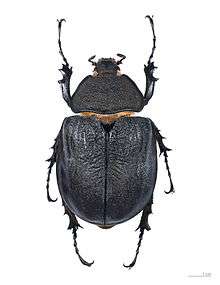Actaeon beetle
Actaeon beetle (Megasoma actaeon) is a rhinoceros beetle of the family Scarabaeidae.
| Actaeon beetle | |
|---|---|
 | |
| Male of Megasoma actaeon | |
 | |
| Female of Megasoma actaeon | |
| Scientific classification | |
| Kingdom: | Animalia |
| Phylum: | Arthropoda |
| Class: | Insecta |
| Order: | Coleoptera |
| Family: | Scarabaeidae |
| Genus: | Megasoma |
| Species: | M. actaeon |
| Binomial name | |
| Megasoma actaeon | |
| Synonyms | |
| |
Etymology
The species name actaeon derives from the name Actaeon of a famous Theban hero, son of the priestly herdsman Aristaeus and Autonoe in Boeotia, trained by the centaur Chiron.
Description
Actaeon beetle is one of the largest of all beetles, measuring up to 7 centimetres (2.8 in) across, with a body length of about 5–12 centimetres (2.0–4.7 in). The males can grow to be 131/2 cm (5.4 in) long by 4 cm (1.6 in) thick .[2]
The dorsal surfaces are glabrous, matte or shiny black. The legs are powerful, with large tarsal claws. Males have appendages resembling horns on the pronotum and on the head. The two parallel horns on the pronotum are short, acute and forward pointing, while a much longer horn with a small tooth is present on the head. In the females the pronotum and the elytra are rugose and the horns are missing.[1]
Life cycle
Females lay eggs into soil at eclosion and eggs develop in about 9 months. Larval development and pupation takes in total almost 3 years. Larvae at the 3rd instar can reach the weight of 200 grams, the highest weight among insects. Life expectancy of adults in captivity reaches about 100–150 days. The heaviest Actaeon ever recorded was found in the northern regions of South America weighed 228 grams (8.04 oz) in 2009 nearly equivalent to a female rat. This not only makes it the heaviest beetle but the heaviest insect of any kind.[3]
Distribution
This species can be found in South America, particularly in Bolivia, Brazil, Colombia, Ecuador, French Guiana, Guyana, Panama, Peru, Suriname, and Venezuela [1]
See also
References
- Generic Guide to New World Scarab Beetles
- "What is the World's Biggest Insect?".
- Glenday, Craig (2013). Guinness World Records 2014. pp. 33. ISBN 978-1-908843-15-9.
External links
| Wikispecies has information related to Megasoma actaeon |
| Wikimedia Commons has media related to Megasoma actaeon. |